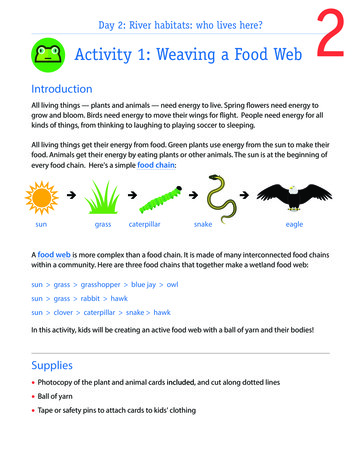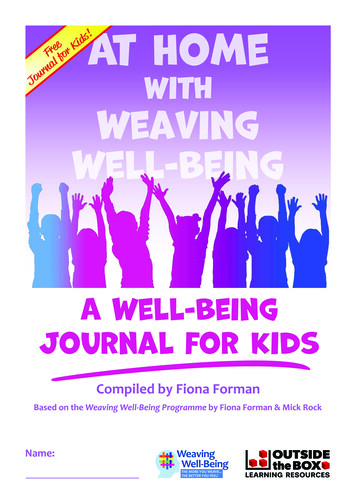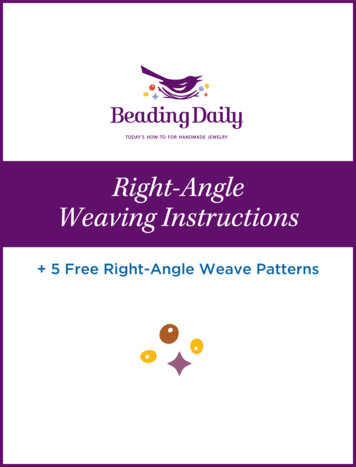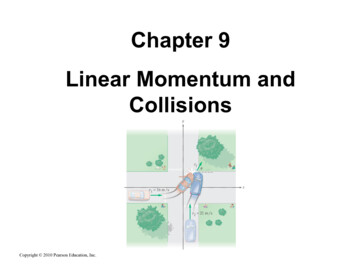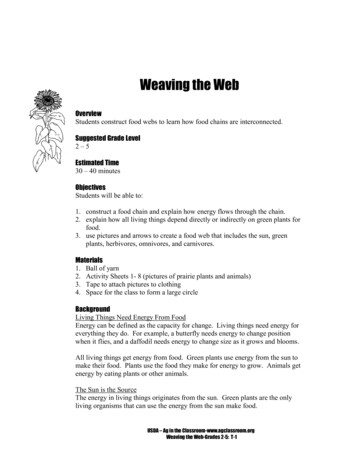
Transcription
Weaving the WebOverviewStudents construct food webs to learn how food chains are interconnected.Suggested Grade Level2–5Estimated Time30 – 40 minutesObjectivesStudents will be able to:1. construct a food chain and explain how energy flows through the chain.2. explain how all living things depend directly or indirectly on green plants forfood.3. use pictures and arrows to create a food web that includes the sun, greenplants, herbivores, omnivores, and carnivores.Materials1. Ball of yarn2. Activity Sheets 1- 8 (pictures of prairie plants and animals)3. Tape to attach pictures to clothing4. Space for the class to form a large circleBackgroundLiving Things Need Energy From FoodEnergy can be defined as the capacity for change. Living things need energy foreverything they do. For example, a butterfly needs energy to change positionwhen it flies, and a daffodil needs energy to change size as it grows and blooms.All living things get energy from food. Green plants use energy from the sun tomake their food. Plants use the food they make for energy to grow. Animals getenergy by eating plants or other animals.The Sun is the SourceThe energy in living things originates from the sun. Green plants are the onlyliving organisms that can use the energy from the sun make food.USDA – Ag in the Classroom-www.agclassroom.orgWeaving the Web-Grades 2-5: T-1
Although many children know that the sun keeps plants healthy, they may notknow that plants rely on the sun’s energy to make food, or that this food can beused by the plant itself or by animals that eat the plant. For example, a sugarmaple tree uses the sun’s energy to make sugar, a food, in its leaves. The treeuses the sugar for energy to grow and stay alive. If people eat maple syrup, theyget energy from the sugar in the tree. But people cannot hold out their hands tothe sun and make food in the same way that a maple tree can make food in itsleaves.Children may think that the sun is important because it keeps animals warm. Thesun does provide warmth to the animals, but, more importantly, the sun providesthe energy that green plants use to produce food. Animals get this energy whenthey eat the plants. To help students understand that animals depend on the sunfor food energy, have them think about how long a deer could live if it onlybasked in the sun and did not eat green plants. The relationship between thesun’s energy and the energy required by living things will become clearer as thechildren learn about food chains and webs.Children may cling to the idea that plants draw in usable food from the soilthrough their roots. It is true that plants absorb water and essential minerals fromthe soil and that they need water to make food. Food contains energy, however,and the water and minerals in the soil do not contain energy. So plants use theenergy from the sunlight plus water and minerals along with carbon dioxide fromthe air to produce food that contains energy.Food ChainsA food chains’ energy is transferred in sequence. For example, energy comesfrom the sun, to green plants, to animals that eat plants, and to animals that eatother animals. Green plants use the sun’s energy directly to make food. Whenanimals eat green plants and other animals eat those animals, the energy movesfrom one living thing to another along the food chain. Animals that eat plants arecalled herbivores, animals that eat both plants and animals are called omnivores,and animals that eat only other animals are called carnivores. Ultimately, allmembers of a food chain depend on the energy from the sun that green plantstransform into food energy.The above diagram illustrates a food chain that might be found in the prairie.Arrows indicate the transfer of energy from one organism to another. The sunprovides energy for the grass, the grass for the caterpillars that eat the grass, andso on.USDA – Ag in the Classroom-www.agclassroom.orgWeaving the Web-Grades 2-5: T-2
Students may want to use arrows to show animals moving toward their food. Itmay be necessary to help students recognize their thinking, as in the followingexample: “Does your arrow show that the frog hops toward the fly to get food?Now, can you draw the arrow to show which way the food energy is going?Does eating the fly give energy to the frog?” As they draw food chains in thisunit, the students will better understand how the sun’s energy passes throughfood chains.Food WebsFood webs are more complex than food chains. They consist of many foodchains that are interconnected. The following example is a series of food chains,which together make a food web.sun grass grasshopper blue jay owlsun grass rabbit hawksun clover caterpillar snake hawkVocabulary/Glossarycarnivore – an animal that eats only animalscommunity – all the plants and animals that live in one place, and that interactand depend on one another.energy – the capacity for change: all living things need energy from food to liveand grow.food chain – transfer of energy in sequence, for example, from green plants, toanimals that eat plants, to animals that eat other animals.food web – a network of food chains that are interconnected within a particularcommunity.herbivore – an animal that eats only plants.interact – to influence one anotheromnivore – an animal that eats both plants and animalsActivity1. Copy Activity Sheets 1 – 8 and cut apart. Have students tape one pictureeach to their chests.2. Tell the students that they will make a food web. Have them stand in a circleand introduce themselves as the plant or animal they represent. The studentwith the sun picture should stand in the center. They should look around andask themselves:Who in the circle could I give my energy to? (Who might eat me?)Who in the circle could give me energy? (Whom could I eat?)USDA – Ag in the Classroom-www.agclassroom.orgWeaving the Web-Grades 2-5: T-3
3. Explain that the ball of yarn represents sunbeams, or energy from the sun.Ask the student representing the sun to hold the end of the yarn tightly andtoss the ball to someone who can use that energy (a green plant). When astudent representing the green plant catches the ball of yarn, he or she shouldhold a piece of the yarn and throw the ball to someone else who could use theenergy. For example, the sun might throw the yarn to the grass, the grass tothe grasshopper, and the grasshopper to the meadowlark. After the yarnreaches a carnivore, break it off to represent one food chain. (Explain thathumans, bears, raccoons, etc. are omnivores and can end a food chain, or theycould be eaten by a carnivore.)After the first food chain is completed, a view from above might look like this.Ask: How can all these other plants and animals get the energy they need?(Through different food chains)4. Return the yarn to the sun to start another chain. This time the sunmight throw its energy to the grass, the grass to the field mouse, and thefield mouse to a great horned owl. Again, break the yarn, throw it back tothe sun, and have the sun start another chain. Continue making chainsuntil every student holds at least one strand of yarn.USDA – Ag in the Classroom-www.agclassroom.orgWeaving the Web-Grades 2-5: T-4
Now a view from above might look like this.Ask:Have we made food chains? (Yes, lots of them!)What do all of our food chains together look like? (A food web.)What is the difference between a food chain and food web? (A food webis made up of several food chains. A web is more complicated than achain because it has connections among the chains.)Who is holding the most pieces of yarn? (The sun.)Why? (Because each food chain starts with the sun.)Who else is part of many food chains? (Green plants)USDA – Ag in the Classroom-www.agclassroom.orgWeaving the Web-Grades 2-5: T-5
What would happen if all the green plants died? (Nothing else in the foodweb could survive.)Ask:How could we show what could happen if one kind of plant, such as allthe clover died? (The student representing clover could pull out his or herpieces of yarn and sit down.)If all the clover is gone, who may have trouble getting enough food?(Identify all the animals that were in food chains that included clover.Whoever had yarn pulled out of their hands might have trouble gettingenough food without the clover.)What happened to our food web? (It is much thinner, less complex, andless strong.)Why should we be concerned about each kind of plant or animal?(Because other plants and animals in the food web may depend on it.)Emphasize that each group is important and applaud each in turn.Will the carnivores please show their teeth?Will the omnivores please shake a leg?Will the herbivores please wink an eye?Will the only living things that can make food using the sun’s energy –green plants – please take a bow?Collect the “Who Eats Who” sheets to save for another activity.Extensions1. Have students identify food chains from other ecosystems (forest, wetland,marine, etc.) and make pictures of the plants and animals from thatecosystem, using arrows to indicate the flow of energy.2. Students can learn about the plant or animal they represented in the food webactivity and write a report, tell a story, or make an illustration about the plantor animal to share with the class.Adapted from Project LEAP: Learning about Ecology, Animals, and Plants, College ofAgriculture and Life Sciences, Cornell University, Ithaca, NY 14853.USDA – Ag in the Classroom-www.agclassroom.orgWeaving the Web-Grades 2-5: T-6
Weaving thethe WebUSDA – Ag in the Classroom-www.agclassroom.orgWeaving the Web-Grades 2-5: S-1Activity Sheet 1
Weaving thethe WebUSDA – Ag in the Classroom-www.agclassroom.orgWeaving the Web-Grades 2-5: S-2Activity Sheet 2
Weaving thethe WebUSDA – Ag in the Classroom-www.agclassroom.orgWeaving the Web-Grades 2-5: S-3Activity Sheet 3
Weaving thethe WebUSDA – Ag in the Classroom-www.agclassroom.orgWeaving the Web-Grades 2-5: S-4Activity Sheet 4
Weaving thethe WebUSDA – Ag in the Classroom-www.agclassroom.orgWeaving the Web-Grades 2-5: S-5Activity Sheet 5
Weaving thethe WebUSDA – Ag in the Classroom-www.agclassroom.orgWeaving the Web-Grades 2-5: S-6Activity Sheet 6
Weaving thethe WebUSDA – Ag in the Classroom-www.agclassroom.orgWeaving the Web-Grades 2-5: S-7Activity Sheet 7
Weaving thethe WebUSDA – Ag in the Classroom-www.agclassroom.orgWeaving the Web-Grades 2-5: S-8Activity Sheet 8
Students construct food webs to learn how food chains are interconnected. Suggested Grade Level 2 - 5 Estimated Time 30 - 40 minutes Objectives Students will be able to: 1. construct a food chain and explain how energy flows through the chain. 2. explain how all living things depend directly or indirectly on green plants for food. 3.

